What's your favorite tree? Check out these 10 favorite trees in Galesburg
Galesburg is home to some impressive trees, from Lake Storey to the campus at Knox College and throughout historic areas of town. In fact, the city of Galesburg enjoys the designation of Tree City USA given by the National Arbor Day Foundation.
The Register-Mail asked three tree enthusiasts to name some of their favorite trees in Galesburg.
What follows is a list of 10 trees from Mayor Peter Schwartzman, Professor Stuart Allison and aborist Charlie Goodrich. Goodrich identified all the trees on the list, calculated their diameter and estimated the height.
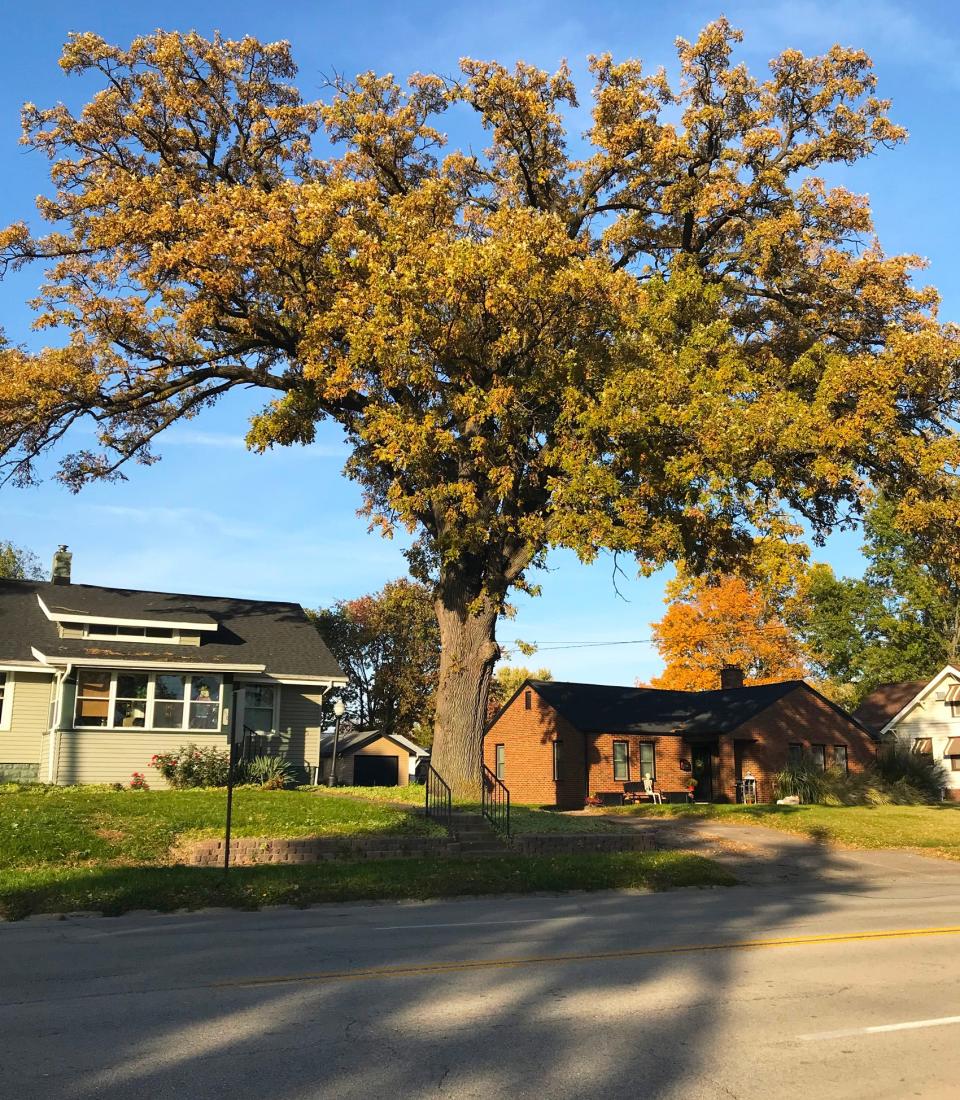
Mayor Peter Schwartzman's favorites
White oak (Quercus Alba)
Where: 1161 W. Main
Diameter: 56" diameter
Height: Approximately 60 feet tall
Tree inventory: 22 white oak trees grow in the public domain in Galesburg
Schwartzman: Our state tree, this tree stands out for me due to its majestic size and age. Imagine the stories it could tell of all that it has seen in Galesburg.
I encountered this tree while canvassing and somehow I didn't notice it at first. Then when I met a family who introduced it to me, I became aware of the significance it had for them and likely others. For many of our residents who have lived in one house for 40-plus years, a tree can serve as a solidifying source of stability — an anchor —something needed during times like these.
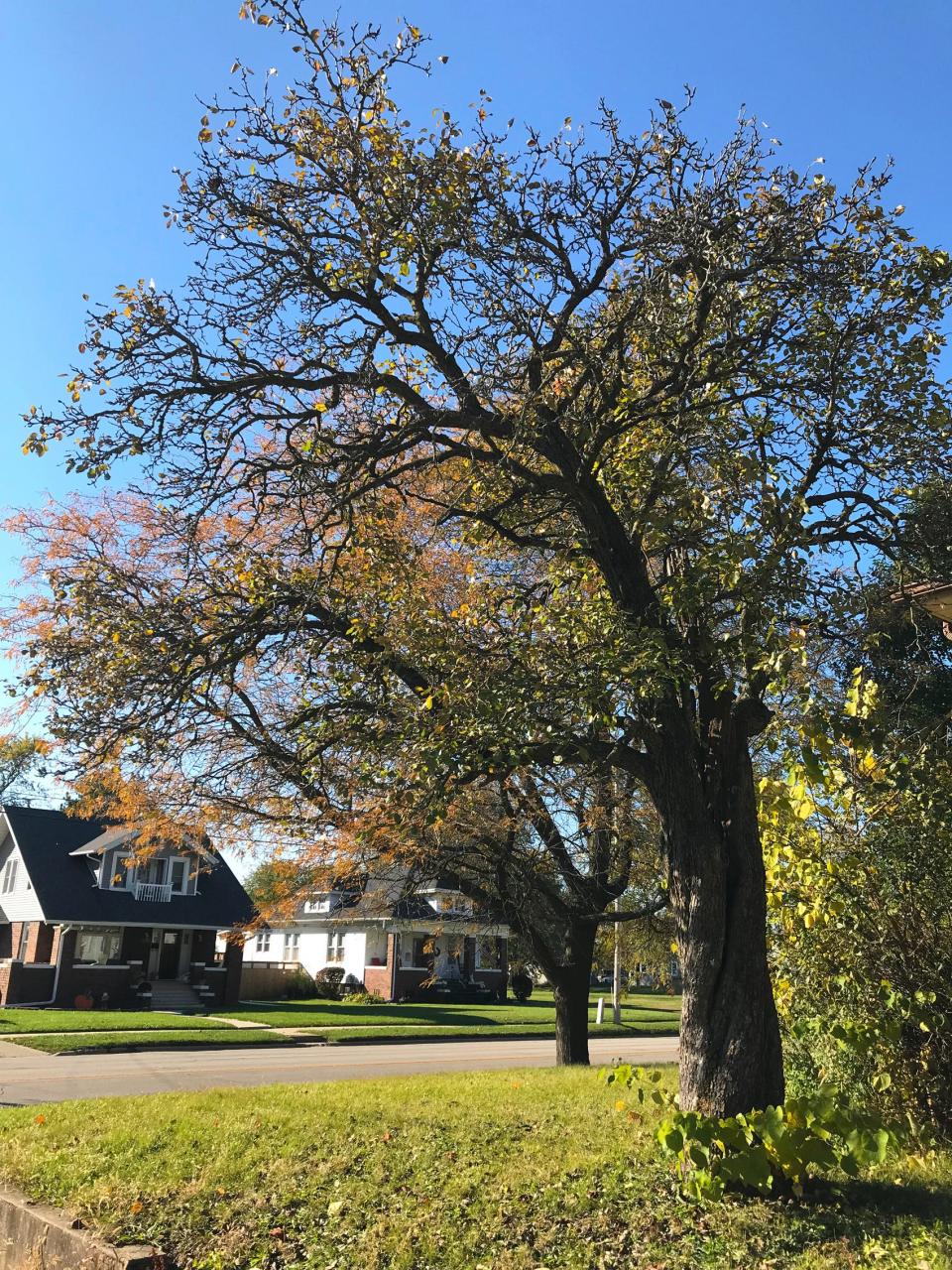
Fruiting variety pear
Where: Corner of Highland and West Main
Diameter: 17"
Height: Approximately 20 feet
Tree inventory: No fruiting pear trees are listed growing in the public domain in Galesburg
Schwartzman: Fruit bearing trees have so much potential to feed the world. A current city council member told me a story about how they would eat breakfast walking to school from the trees that shared their bounty. Sadly, fewer of these trees seem to be planted today. As it often takes five or so years for young trees mature, it takes a big investment before one sees the fruits of one's labor. Keep in mind that Seed Savers, in northeast Iowa has an apple grove with over 800 different varieties of apples! Wow!
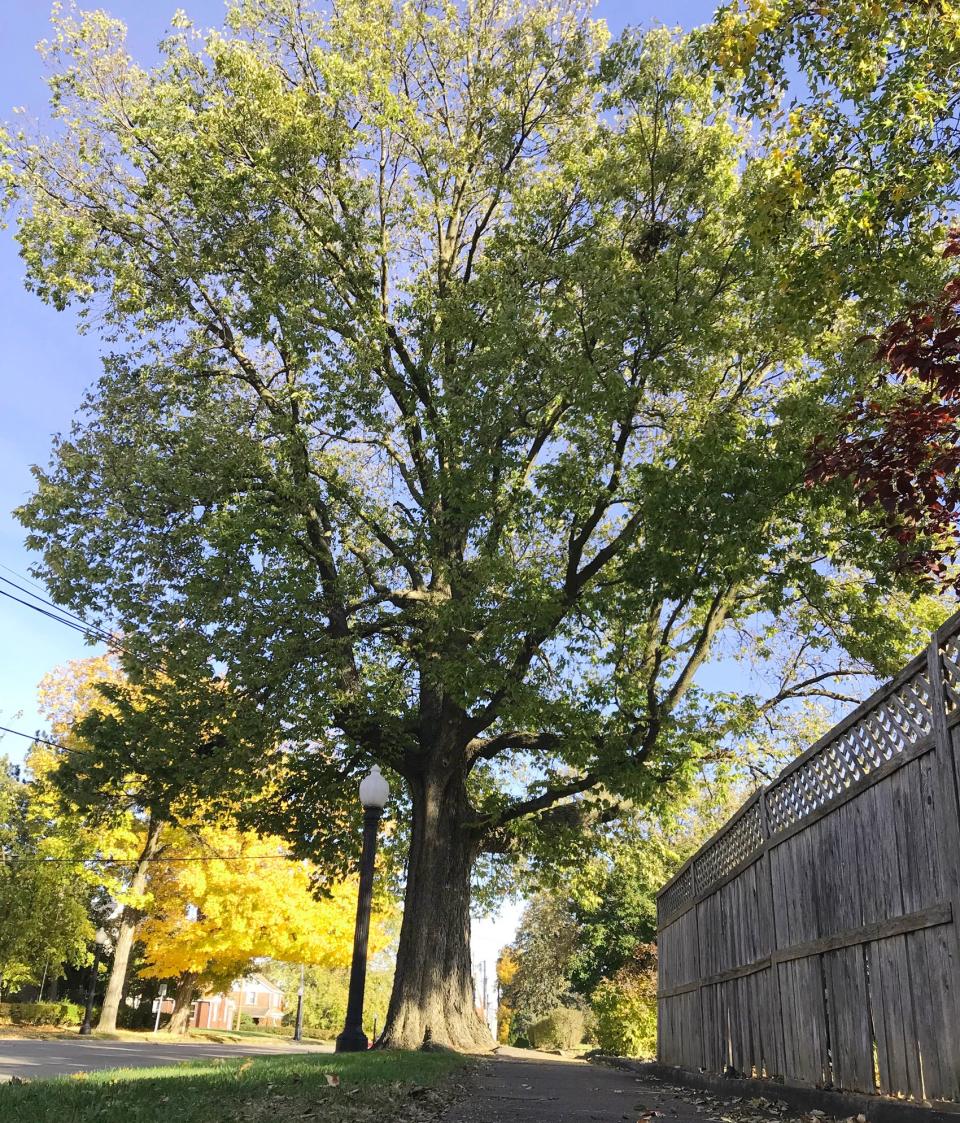
Hackberry (Celtis occidentalis)
Where: Just west of 564 E Losey (on south side of street)
Diameter: 50" diameter
Height: Approximately 60 feet
Tree inventory: 14 hackberry trees grow in the public domain in Galesburg
Schwartzman: This gargantuan tree met me every morning for a dozen years on my way to work. I couldn't miss it as it hovered over West Losey Street taking up the full width of the terrace. Consider that a tree of this advanced age also has endured dozens of intense storms, yet stands secure and healthy.
Consider how many birds or squirrels (or other important creatures) have taken refuge in this tree over time. Trees, especially large ones, have expansive root systems that absorb huge volumes of water, keeping our streets traversable even during a torrential rain.
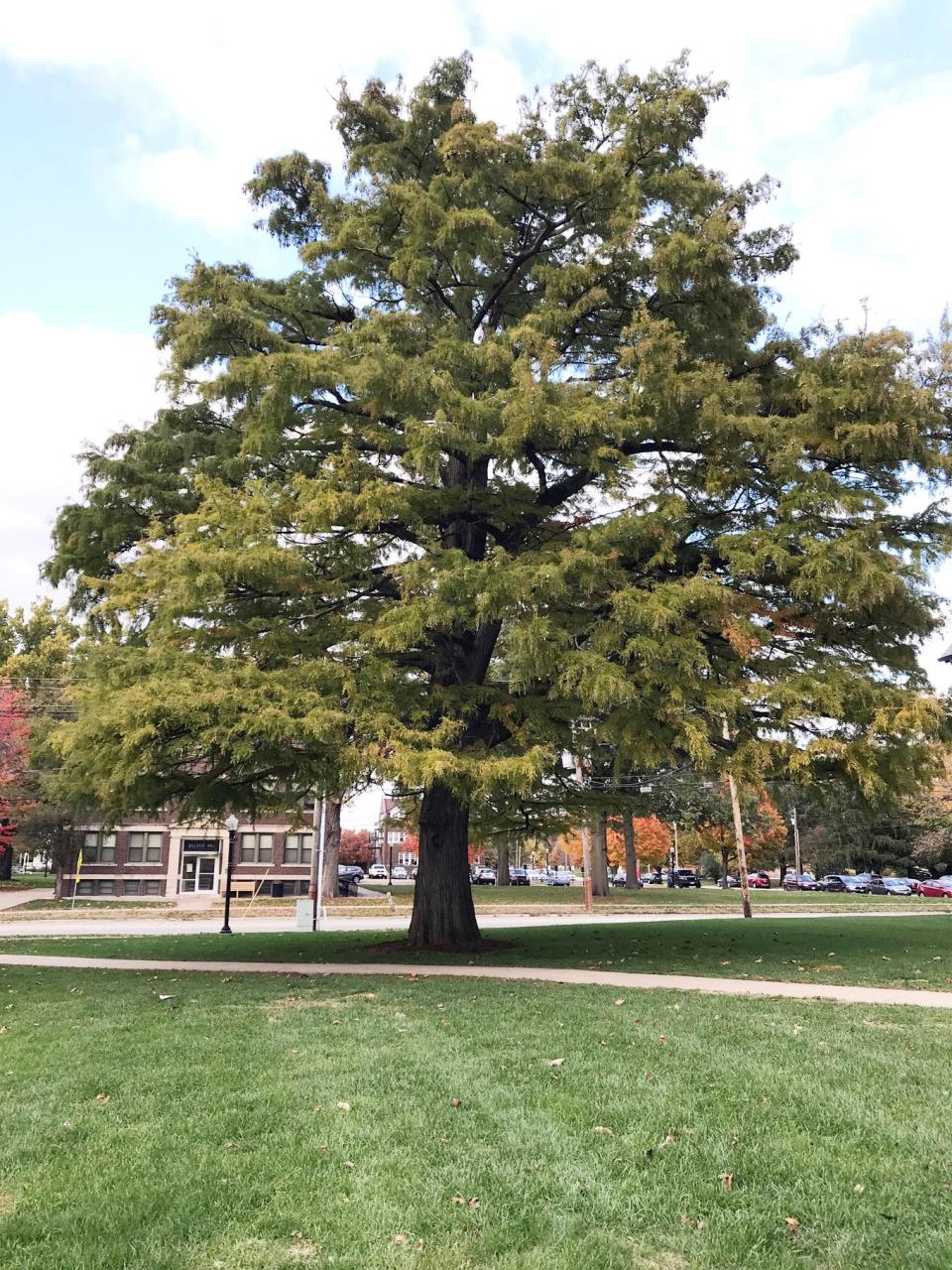
Stuart Allison's Favorites
Bald cypress (Taxodium distichum)
Where: Between the TKE and Beta houses on the Knox College campus – close to South Street)
Height: 45 feet?
(Arborist measurements not available)
Tree inventory: 39 bald cypress trees grow in the public domain in Galesburg
Allison: This bald cypress is another Knox Campus tree that I see almost every day. It is a beautiful, well-shaped example of a bald cypress. There are several bald cypresses on campus and around town (including my own lawn) but this one is the prettiest. It has grown in an open area, free to spread its branches and assume a graceful, classic triangular conifer shape. Several years ago the tree was struck by lightning, so the top 3 or 4 feet of the trunk is bare, highly polished gray wood. The bare top signals that this bald cypress is a grizzled survivor and that it continues to grow well despite weathering many years of storms and trials. I also love that aspect of the tree.
Strictly speaking, bald cypress is not a native tree either. They occur in southern Illinois, but they are not naturally found this far north. However, if planted here they grow well and make excellent urban and suburban trees.
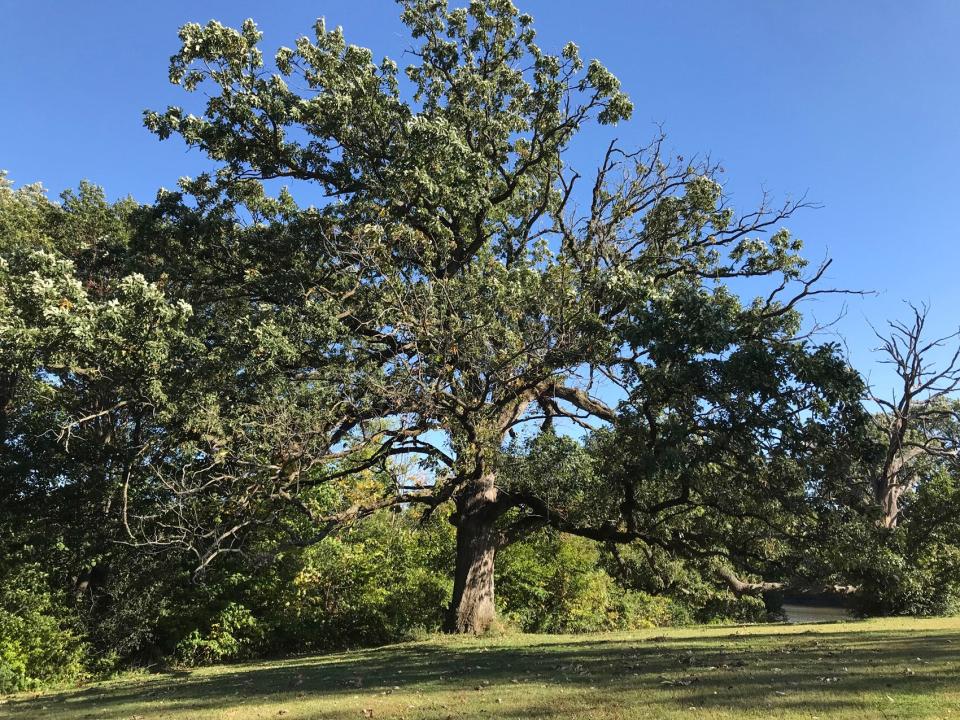
Bur oak (Quercus macrocarpa)
Where: Lake Storey, just to the east and slightly downhill from the swings and playground equipment on the north side of the lake and the east side picnic shelters. There are two bur oaks there — one is dying or dead, the second (this one) is still thriving.
Diameter: 57"
Height: Approximately 60 feet tall
Approximate age: 160 years?
Tree inventory: 150 bur oak trees grow in the public domain in Galesburg
Allison: The Illinois state tree is the white oak but for this part of the state the most distinctive native trees are the bur oaks. They aren’t as stately as the white oaks. Bur oaks tend to be more squat with thick trunks and gnarled limbs. They are adapted to survive prairie fires and have extremely thick bark that insulates them from the flames. This bur oak is huge, with long branches spreading far wider than the tree is tall, branches that form magnificent Us and Js as they reach to the ground and then climb back towards the sky.
This is a very old tree, a survivor of the days before Lake Storey or the park existed. There used to be an even older and bigger bur oak right beside the road along the north side of Lake Storey Park, but it blew down in a storm a few years ago. I got a massive section of its trunk and counted the rings — about 185. It was a little older than the city of Galesburg. This tree is a little smaller so my guess is that it is probably 160 years old, but still a survivor of the early days of the town. As such it is a magnificent reminder of what this area was like before we arrived. Other massive old bur oaks are dying. I hope this one continues to live for many, many years, the patriarch of our park.
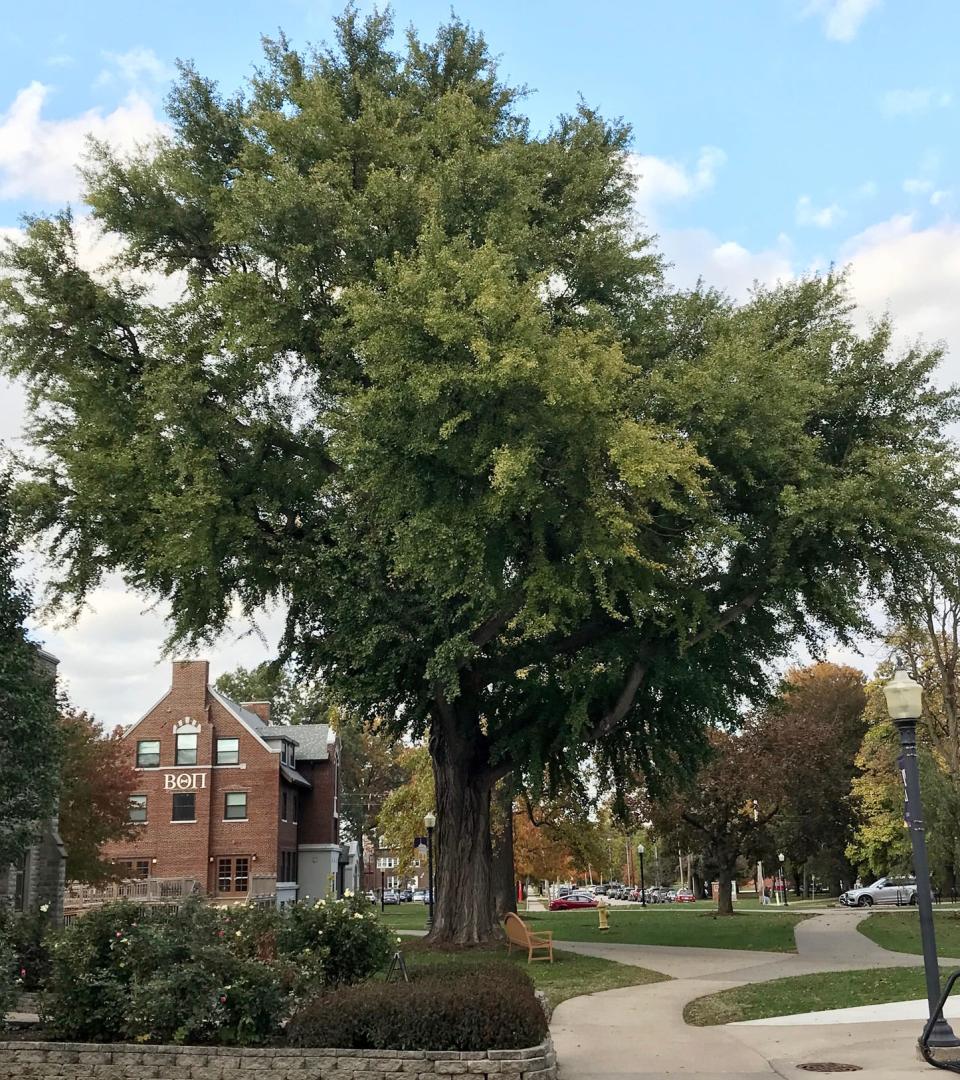
Gingko (Gingko biloba)
Where: By the front entrance to Seymour Library, Knox College campus
Diameter: 59"
Height: Approximately 60 feet
Estimated age: 130-140 years?
Tree inventory: No gingko trees are listed as growing in the public domain in Galesburg
Allison: Because I’m a professor at Knox and I spend a lot of time on campus, this ginkgo is a tree I see almost every day. It is not just one of my favorite trees in Galesburg, it is one of my favorite trees anywhere in the world. It is a truly magnificent specimen of ginkgo. It has a tall, straight, strong, well-shaped trunk with massive branches reaching out to the sides. The tree is a huge piece of organic, living sculpture. This ginkgo behaves just like a ginkgo should, dropping almost all of its leaves on the day after the autumn’s first hard frost. On the day the leaves fall, there is a gentle blizzard of leaves falling to the ground, falling so fast and thick that soon the ground is ankle deep in ginkgo leaves. I suppose the grounds crew doesn’t like that so much, but to me it is wonderful. If I am lucky enough to walk past while the leaves are falling, I have to stop and stand under the tree, allowing the falling leaves to waft down onto me. The Knox library staff used to have a contest in which people would try to guess the date of the leaf fall. The ginkgo was planted by Professor Standish (Standish Park is named for him) so it has to be about 130 to 140 years old.
Some of my friends and colleagues who are native plant enthusiasts wonder why I love a ginkgo so much – after all it isn’t a native tree. But ginkgoes only have one tiny, remnant wild population in China today. For the most part they only exist in urban and suburban lawns and gardens. They are completely dependent on us maintaining them, so the lawn at Knox is as close to its current native habitat as anyplace else.
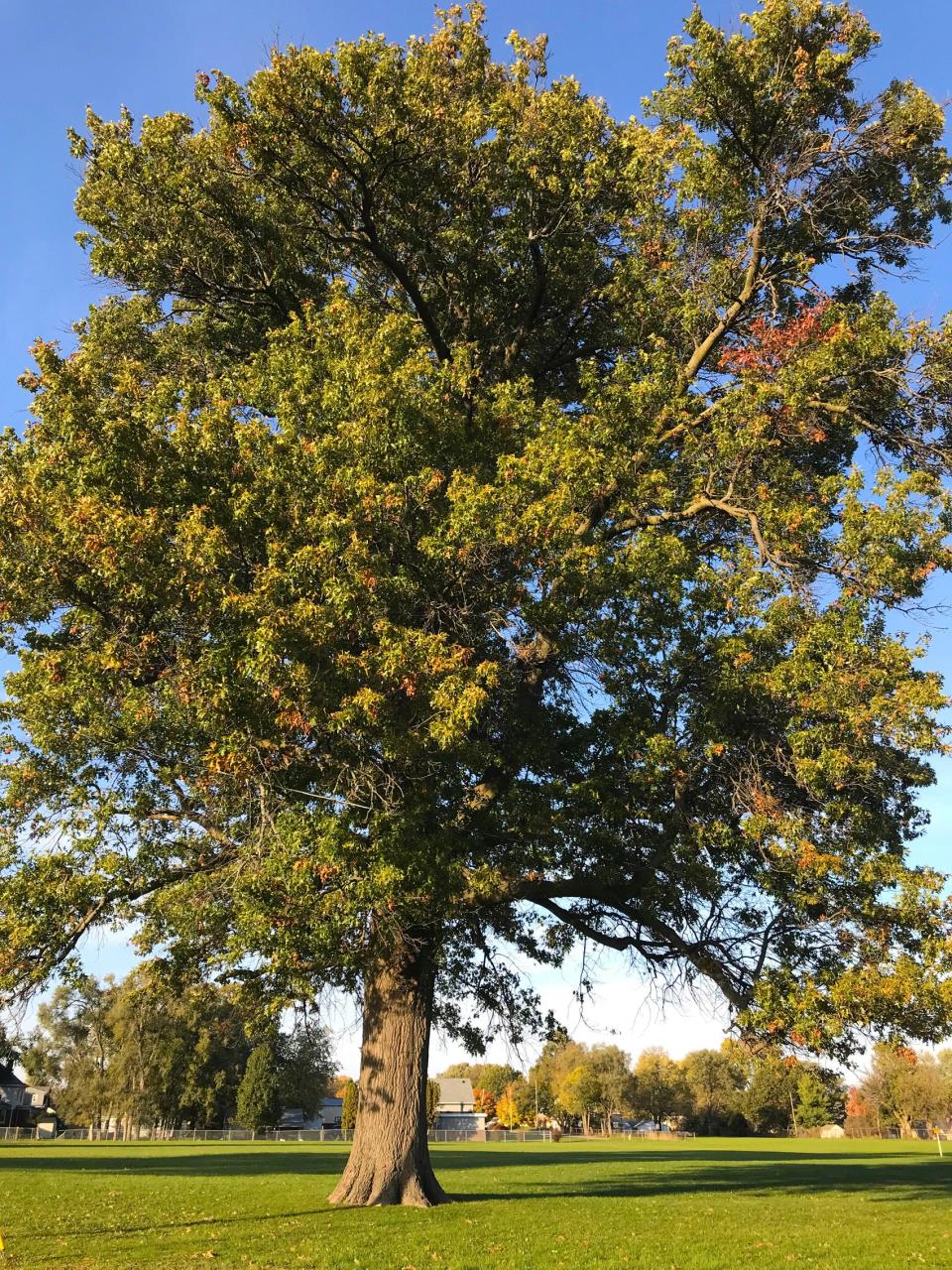
Pin oak (Quercus palustris)
Where: Churchill Junior High School – just north of the school, in the large open lawn. This tree is the tallest one there, close to the little storage shed on the edge of the parking lot/alley.
Diameter: 59"
Height: Approximately 70 feet
Tree inventory: 220 pin oak trees grow in the public domain in Galesburg
Allison: This northern pin oak is a beautiful tree — growing straight and tall, with a well-developed crown. Its lower branches have been trimmed away so the trunk seems especially tall and well formed. It stands somewhat isolated from other trees and thus seems like a sentinel watching over the school and the nearby park. It is especially striking when walking south along Clark Street, where the street dead ends on the park. From that vantage point, the tree stands out as a truly magnificent tree.
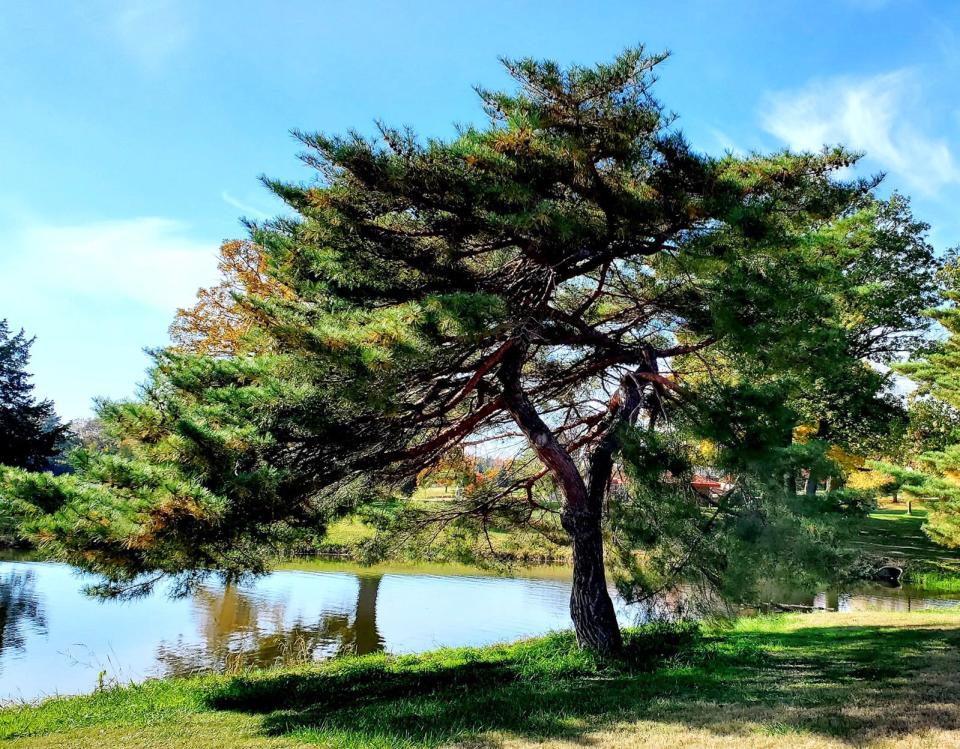
Scotch Pine – (Pinus sylvestris)
Where: Lakey Storey Park – this pine is on the north side of the lake, on the lakeshore, just south of parking lot for the three picnic shelters and play equipment. It is on a little inlet just across from the waterslide.
Tree height: about 25 feet
Trunk diameter: About 30"
Estimated age: 30 years?
Allison: This Scotch pine stands out for its growth form and location. Early in its life the trunk divided into two main branches. The branch closest to the lake supports a crown of needles that stretches from slightly above the ground to about 25 feet in the air with the crown forming a perfect 45 degree angle. The branch away from the lake isn’t as well developed. The tree looks like a mountain tree that grew on a rocky crag exposed to fierce winds, shaping it into strong wing-shaped tree built to withstand gales. Of course, it didn’t grow up in those kinds of conditions but it gives the appearance of ancient age obtained in a harsh environment – rather like trees grown for bonsai. Here Mother Nature created the bonsai. Because of its position on the lakeshore, it stands out, appearing isolated when viewed from the right angle, reflected in the water.
Scotch pine is another non-native species. It is a commonly introduced European species, readily identified by the orange bark on the upper branches. My father always liked to get Scotch pines for our Christmas trees so I have many good memories of them.
Charlie Goodrich's favorites
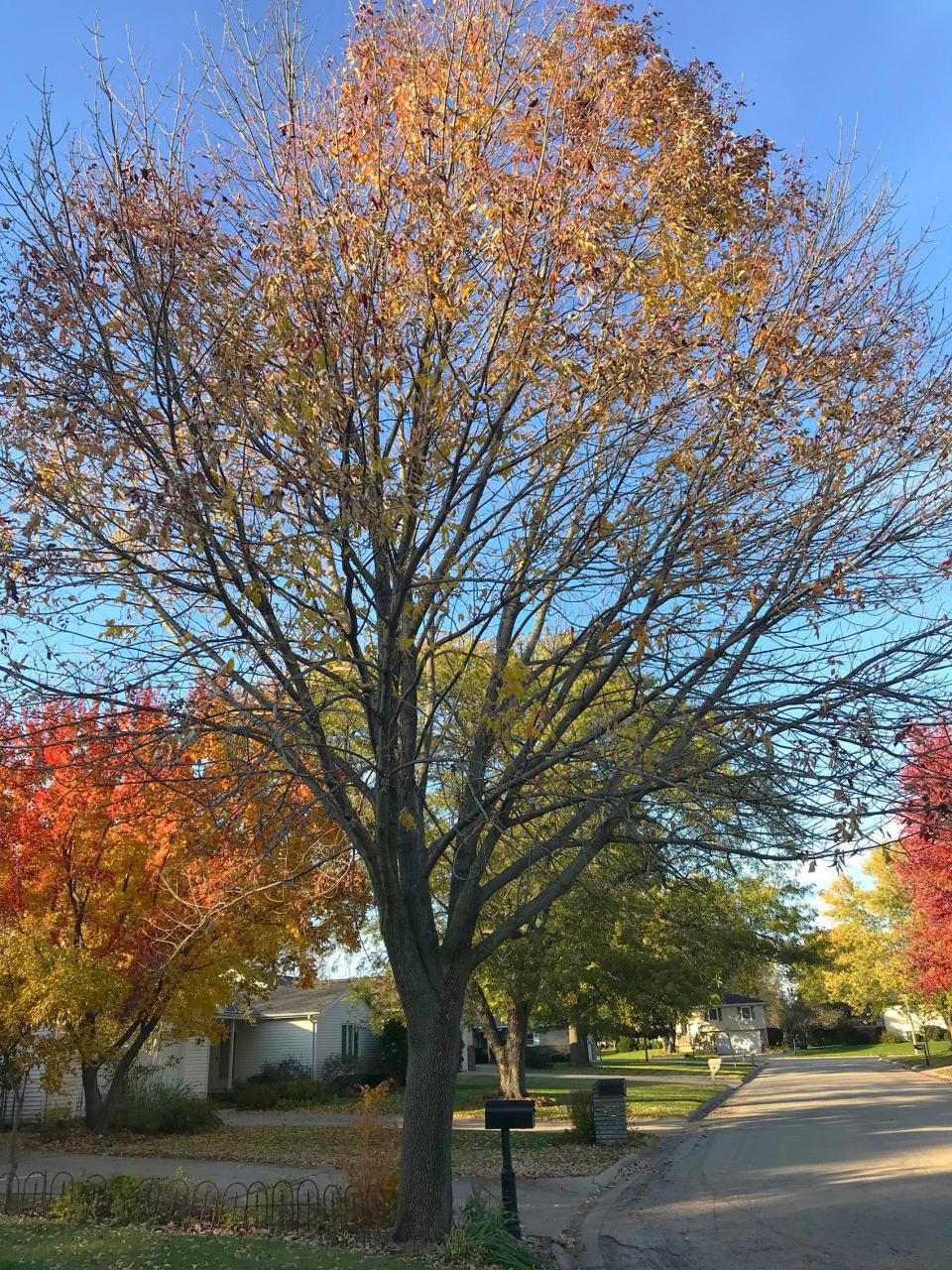
White Ash Tree (Fraxinus americana)
Where: 856 Lilac Lane (next to Rotary Park)
Diameter: 17"
Height: Approximately 30 feet
Tree inventory: 170 white ash trees grow in the public domain in Galesburg
Goodrich: One of the surviving ash trees we have been treating for Emerald Ash Borer. This tree has a beautiful fall color that has some purple and yellow.
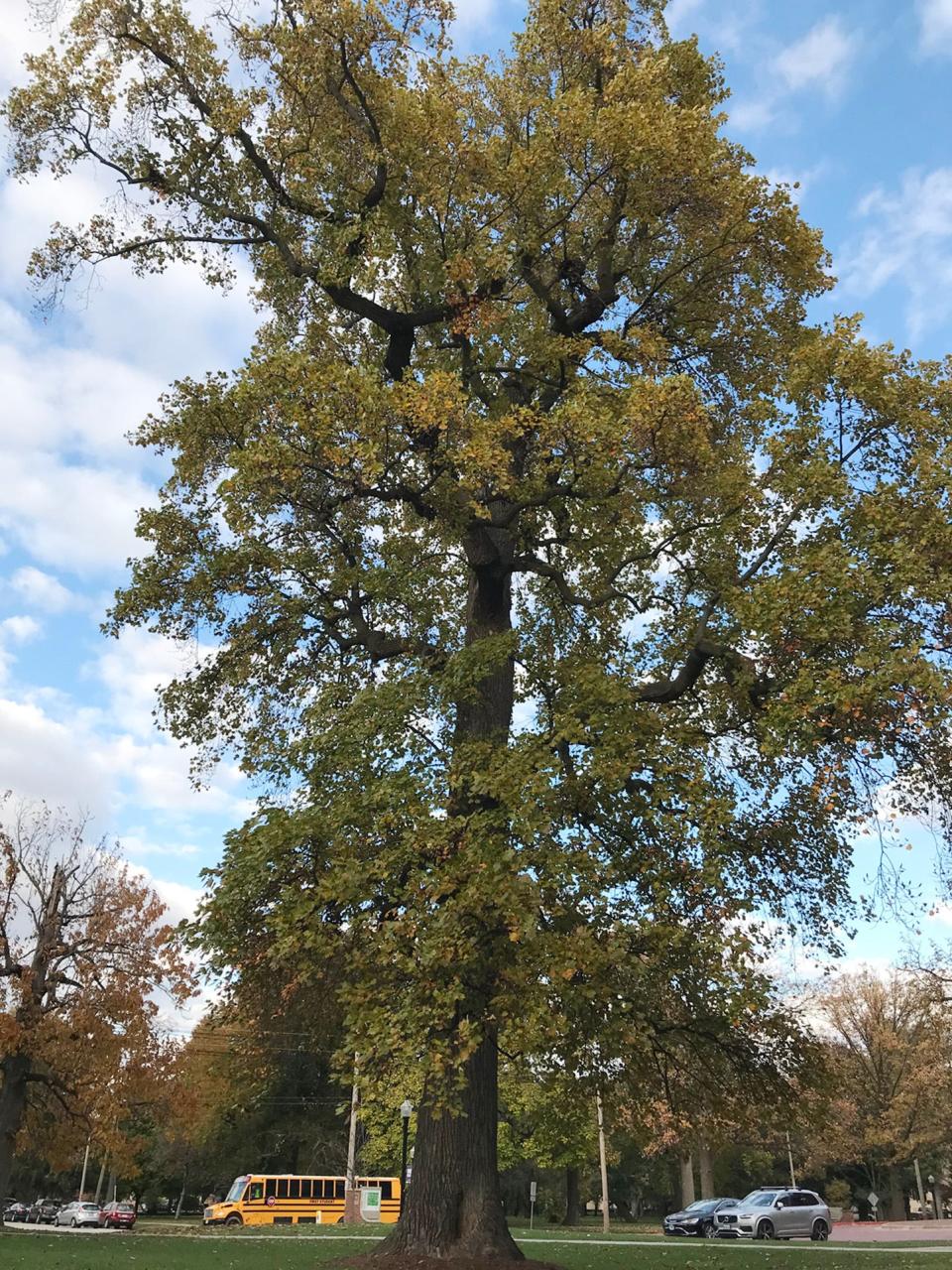
Tuliptree (Liriodendron tulipifera)
Where: East of Beta Theta Pi house on Knox College campus
Diameter: 60" diameter
Height: Approximately 60 feet
Tree inventory: 38 Tuliptrees grow in the public domain in Galesburg
Goodrich: This tree is often called a tulip poplar but is actually in the Magnolia family. This tree has a unique leaf and has a large flower.
About the tree enthusiasts
Charlie Goodrich of Galesburg became a certified arborist in 2012 and has a bachelor's degree from Western Illinois University. He has worked for Liqui-Green Lawn and Tree Care since 2005. He has been the site leader for Saluting Branches, Arborists United for Veteren Remembrance every year it has been held at the Rock Island National Cemetery at Arsenal Island.
Stuart Allison of Galesburg is the Watson Bartlett Professor of Biology and Conservation at Knox College. He has a Ph.D. in Biology from the University of California Berkeley. He also writes a monthly column for The Register-Mail.
Peter Schwartzman is is a professor of environmental studies at Knox College with a Ph.D. in Environmental Sciences from the University of Virginia. Schwartzman has served as 5th Ward alderman and is the current mayor of Galesburg.
Galesburg tree inventory
The city's website has an interactive tree inventory map that lists 7,378 trees in public areas of Galesburg. The most common trees in public areas are sugar maple (859), Southern redcedar (481), Silver maple (453), and red maple (379). Here is a list of the public domain trees with counts above 100.
Galesburg tree inventory: most populated
Apple: 294
Black walnut: 146
Blue spruce: 239
Burr oak: 150
Callery pear: 104
Capula: 255
Common hackberry: 148
Eastern white pine: 218
Honey locust: 203
Northern red oak: 145
Norway maple: 205
Norway maple (crimson king): 166
Norway spruce: 157
Pin oak: 220
Red maple: 379
Siberian elm: 105
Silver maple: 453
Southern redcedar: 481
Sugar maple: 859
Swamp white oak: 204
White ash: 170
This article originally appeared on Galesburg Register-Mail: Gingko, white oak among favorite picks of tree buffs in Galesburg

